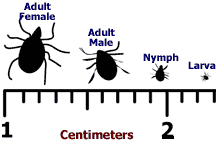The other tick family is named Ixodidae and these ticks possess the hard outer covering, and therefore, are termed hard-shelled ticks.
The following is a listing of the common hard-shelled (Ixodid) ticks and their habitats:
Amblyomma americanum is the Lone Star Tick and is found throughout the South, east of the Rocky Mountains.
Amblyomma maculatum is the Gulf Coast Tick, and that is where it resides.
Dermacentor albipictus is also called the 'Winter tick,' 'Moose Tick,' or 'Elk Tick' and is found in the northern and western United States as well as Canada.
Dermacentor andersoni is the Rocky Mountain Spotted Fever Tick and transmits the deadly disease for which it is named.
Dermacentor variabilis is one of the most famous of all. Its name is also the American Dog Tick and lives in the entire eastern 2/3 of the United States.
Rhipicephalus sanguineus is the king of ticks. It is called the Brown Dog Tick and is a serious threat to kennels anywhere in the United States.
Ixodes scapularis is a tiny little tick with a huge threat. It is also known as the Deer or Black-legged Tick. It has one claim to fame and that is it transmits Lyme disease.
All of the above are 'hard-shelled' ticks. There are more, but these are the most frequently encountered.
The soft-shelled ticks or Argasids are fewer in number. The one most known is Otobius megnini also known as the Spinose Ear Tick. It is most common in the Southwest and as one might guess, loves to attach itself and feed on ears.
Tick Anatomy
All ticks have three pairs of legs during the immature stage and four pairs as an adult. They crawl but cannot fly. Wings are absent. In addition, ticks possess a sensory apparatus called Hallerís organ. This structure senses odor, heat, humidity, and you. This is how the ticks locate their food source. They climb upon tall grass and when they sense an animal is close by, they crawl on.
What do ticks eat?
A tick's diet consists of blood and only blood. Your blood, dogsí blood, catsí blood, and most blood. The tick imbeds its mouthparts into the animal's (or human's) skin and sucks the blood. Except for the eggs, ticks require a blood meal to progress to each successive stage in their life cycle.
What is the life cycle of ticks?
 Most ticks are what we call three host ticks, that is, during their development which takes two years, they feed on three different hosts. All ticks have four stages to their life cycle: egg, larvae (seed tick), nymph, and adult. Let us look at the life cycle of the deer tick, as an example.
Most ticks are what we call three host ticks, that is, during their development which takes two years, they feed on three different hosts. All ticks have four stages to their life cycle: egg, larvae (seed tick), nymph, and adult. Let us look at the life cycle of the deer tick, as an example.
Adult female deer ticks lay eggs on the ground in spring. Later in the summer (depending on moisture and temperature), the eggs hatch into larvae. The larvae, which are smaller than the period at the end of this sentence, find an animal (the first host, which is usually a bird or rodent), live off its blood for several days, then detach and fall back onto the ground. For deer ticks, this most commonly occurs in the month of August. In the ground, the well-fed larvae now molt into the next stage and are called nymphs.
Each female tick lays approximately 3,000 eggs.
The nymphs remain inactive during the winter months and in spring become active. The nymph now finds an animal (the second host - a rodent, pet, or human) and feeds again. Once well fed, the nymph detaches and falls back to the ground. Here it molts and changes into an adult. Throughout the fall, both adult male and female ticks now find another animal (the third host - a rodent, deer, pet, or human) and feed on blood and mate. Once well fed, both males and females fall back to the ground. The male now dies and the female lives through the winter and lays eggs in the spring, completing the cycle. If the adults cannot find a host animal to feed on in the fall, they will survive in the leaf litter until the next spring when they will feed, mate, and produce eggs.
Other species of ticks may be at peak activity for each life stage at different times of the year than the deer tick we described. Your local university or health department may have information on peak tick activity in your area.
What diseases do ticks transmit?
Ticks can transmit or cause:
- Babesiosis (Piroplasmosis)
- Cytauxzoonosis
- Ehrlichiosis
- Haemobartonellosis
- Hepatozoonosis
- Lyme Disease
- Rocky Mountain Spotted Fever
- Tick Paralysis
- Tularemia
© 2000 Drs. Foster and Smith, Inc.
Reprinted as a courtesy and with permission from
PetEducation.com (http://www.PetEducation.com)
On-line store at http://www.DrsFosterSmith.com
Free pet supply catalog: 1-800-323-4208


